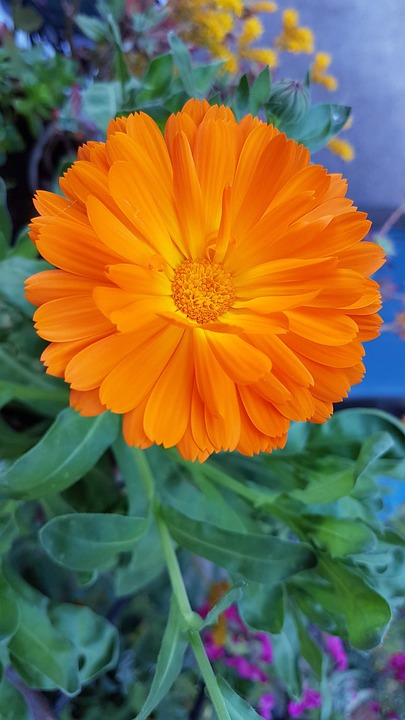Are you looking for Calendula Companion Plants? Then check out this list of good neighbors for this flowering plant.
Look at the best Calendula Companion Plants. They do not just look beautiful but also offer many benefits to gardeners. These pretty blooms offer medicinal properties and can attract beneficial insects.
Read: Black Walnut Companion Plants
Calendula Companion Plants

1. Yarrow
Botanical Name: Achillea millefolium
Yarrow is a drought-tolerant perennial with feathery foliage and flat-topped clusters of flowers. It attracts beneficial insects such as ladybugs and parasitic wasps, which prey on garden pests like aphids and caterpillars. The ability of yarrow to improve soil health through its deep root system also benefits neighboring plants like calendula.
2. Asparagus
Botanical Name: Asparagus officinalis
They work together for a long time in the garden because they come back every year. Calendula plants help stop beetles that can hurt asparagus, which makes the asparagus plants healthier.
3. Chamomile
Botanical Name: Matricaria chamomilla
Chamomile is a good companion to Calendula. It brings in helpful insects like parasitic wasps and hoverflies that eat aphids.
4. Dill
Botanical Name: Anethum graveolens
Dill is a beneficial companion plant for calendula due to its ability to attract hoverflies and predatory insects that feed on aphids, caterpillars, and other common garden pests.
5. Beans
Botanical Name: Phaseolus vulgaris
Beans are a type of plant called legumes. They add nitrogen to the soil, which helps Calendula plants grow better and support each other.
6. Lavender
Botanical Name: Lavandula spp.
Popular for its calming fragrance and beautiful purple blooms, lavender attracts pollinators and repels pests such as fleas and moths, making it an ideal companion for calendula and other garden plants.
7. Lettuce
Botanical Name: Lactuca sativa
Calendula offers shade and cooler ground conditions, creating an ideal environment for lettuce, particularly during warmer months. They complement each other well in the garden!
8. Cucumbers
Botanical Name: Cucumis sativus
Planting cucumbers alongside fences or on trellises maximizes space utilization while also offering protection against common pests such as squash beetles and flea beetles with the help of calendula.
Read: What Does Calendula Smell Like?
9. Carrots
Botanical Name: Daucus carota
The pest repelling pest-deterring properties of calendula help carrots, especially against flea beetles and aphids. Make sure proper spacing must be about a foot apart to prevent overcrowding.
10. Salvia
Botanical Name: Salvia spp.
The violet flowers of Salvia beautifully complement the appearance of Calendula. Both of these plants attract pollinators and continue to bloom throughout the season.
11. Geranium
Botanical Name: Pelargonium spp.
Calendula aids in deterring slugs that may otherwise feed on geraniums. Safely pairing these two plants in your vegetable garden can be beneficial.
12. Potatoes
Botanical Name: Solanum tuberosum
Both calendula and potatoes flourish in full sun. Calendula plays a protective role by warding off rabbits from potato leaves. Additionally, it emits compounds that discourage root-knot nematodes, thereby reducing blemishes on potatoes.
13. Roses
Botanical Name: Rosa spp.
Incorporating Calendula flowers creates a balanced blend in your space, whether alongside white, red, or pink roses. They flourish in comparable conditions, enhancing the beauty of your garden.
14. Chives
Botanical Name: Allium schoenoprasum
Calendula acts as a beneficial companion to chives by attracting insects such as ladybugs, which feed on pests like aphids or caterpillars that pose a threat to these plants.
15. Strawberries
Botanical Name: Fragaria × ananassa
In full bloom, they complement each other not only in growth but also in appearance. Calendula attracts beneficial insects like hoverflies, which aid in pollinating strawberries, further enhancing the symbiotic relationship between these plants.
16. Nasturtiums
Botanical Name: Tropaeolum
These colorful annual flowers not only complement the bright blooms of calendula but also act as a trap crop for aphids, diverting them away from more valuable plants.
17. Basil
Botanical Name: Ocimum basilicum
This aromatic herb not only enhances the flavor of tomatoes and peppers but also repels mosquitoes and flies when grown alongside calendula in the garden.
18. Borage
Botanical Name: Borago officinalis
The attractive blue flowers and cucumber-like flavor of borage attract pollinators and improve the flavor of nearby vegetables while also deterring pests such as tomato hornworms.


